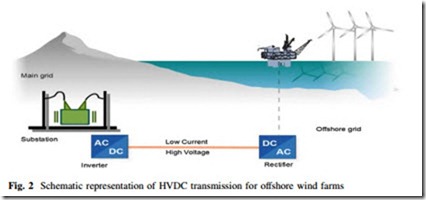Challenges of Offshore Wind Energy
Offshore wind energy has several advantages compared to conventional onshore- based wind facilities, i.e., less visual impact and auditory contamination, reduced user conflicts, and high-power capability [12]. These characteristics allow the use of wind turbines with high-power ratings and customized power electronic converters as will be presented later in this chapter. Turbines up to 10 MW are planned for offshore applications [13].
Most of the future wind farms are expected to be placed at deep water offshore due to the better conditions of wind in terms of magnitude and constancy in such places. Transmitting power at long distances is certainly a challenge that must overcome considering a trade-off between efficiency and investment cost. In these conditions HVDC transmission is the most cost-effective alternative as shown in Fig. 1. The break-point between HVAC and HVDC is not unequivocal defined and depends on many factors including the type of HVDC technology and the cable to be used [14]. A break-point of 40 km is accepted for submarine cables. Most future OWFs are expected to be placed beyond this distance.
Despite the constant development of the HVDC technology in the last decade, it must to be adapted to certain specific conditions of offshore facilities. In particular for the grid integration of OWF, HVDC faces new challenges such as:
• Footprint. The weight and the space occupied by the HVDC stations have a significant impact on investment costs.
• Efficiency. Offshore projects can be more affordable minimizing power losses in the system.
• Reliability. The cost of non-harvested energy due to unavailability of the transmission system can be crucial to make a profitable offshore project.
• Harsh environment. There is a limited access for maintenance.
For instance, power density and power-to-weight ratio must be carefully considered during the design of the components to be placed offshore in order to reduce investment and operative costs. On one hand, investment costs are directly related to the power-to-weight ratio due to the platforms required to support the components placed offshore. On the other hand, operative costs are related to the transportation of spare parts from shore during maintenance. The latter aspect imposes additional requirements in terms of reliability of the offshore components as will be presented later in Sect. 4
A conventional HVDC transmission approach is shown in Fig. 2. It consists of three main components: a rectifier, a submarine cable, and an inverter. Submarine cables deal with high capacitive effect which must be considered in transient studies. The rectifier and the inverter are usually based on the same type of technology. Their principal difference is in the control and operation rather than the component itself. Nevertheless, new hybrid topologies can be used due to the unidirectional characteristic of the power and the aforementioned requirements of offshore wind energy.
